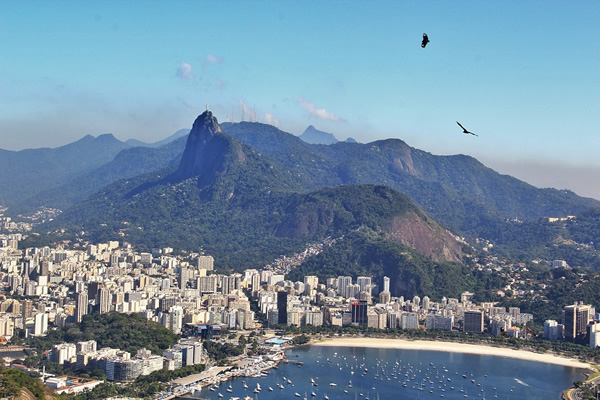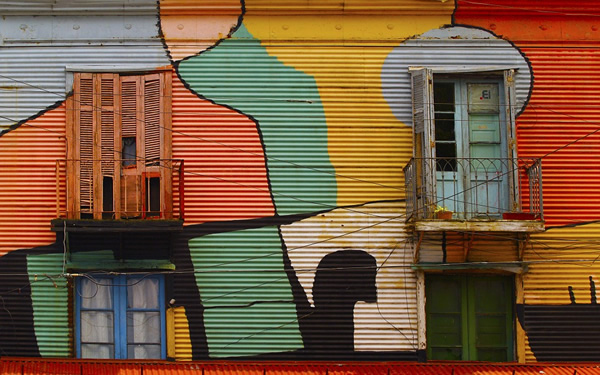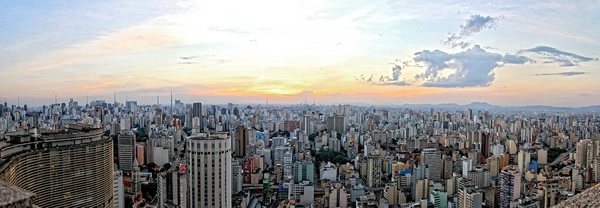A Visitor Guide to South American Megacities
By Volker Poelzl

|
|
One view of the unique Rio de Janeiro skyline and landscape.
|
South America is home to the world's largest rainforest, one of the tallest mountain ranges, and megacities among the world's largest metropolitan areas. While most visitors visit South America to see Inca ruins, the Amazon rain forest, and some of the continent's many natural wonders, few visitors can avoid a stopover in one of South America's largest cities. The metropolitan area of São Paulo has 22 million inhabitants and is the world’s 4th largest city; Greater Buenos Aires has over 15 million people and ranks as the world’s 13th largest metro area; Greater Rio de Janeiro has over 13 million inhabitants, and is the world’s 19th largest city.
From my experience, it can be quite a challenge to get your bearings in these large urban areas and spend a few enjoyable days there, especially when planning to hike in the Andes or explore the rainforest and are not well prepared for a city visit. Still, with a little bit of planning and research, visitors can have an enjoyable time in South America's megacities, even if they are not the primary destination of your trip.
Gaining Your Bearings in Large Cities
South America's large cities are impenetrable concrete jungles, and orientation is nearly only possible with the help of a detailed map. While landmarks such as Pão de Açucar (Sugar Loaf Mountain) in Rio de Janeiro provide some visual orientation, São Paulo is an endless sea of skyscrapers without any distinguishable landmarks. The street plan is so confusing that during my first days in São Paulo, I got lost several times in a maze of high-rises, viaducts, and freeway overpasses. Buenos Aires also covers a vast geographic area and is relatively flat.
Still, the distinct neighborhoods that make up the city make it relatively easy for visitors to get their bearings.
Yet none of these cities have an orderly or rectangular layout, which can make orientation difficult. Even streets that appear to be parallel or perpendicular may lead you in a completely different direction than you desire. The best strategy is to arrive with a plan, a good guidebook, a city map, and a healthy sense of adventure to avoid wandering around aimlessly and getting lost.
Plan Ahead and Take Your Time
The less time you have, the more important it is to plan ahead. Select a few sites and attractions that interest you the most and plan the rest of your visit around them. If you are jet-lagged, give yourself extra time since you won't be able to fit in three museums and visit the most picturesque neighborhoods all in one day. Factor in downtime to relax during the day.
You may save a lot of time by munching on a sandwich while in the cable car up to Rio's Sugar Loaf Mountain. Still, if you plan on visiting many sites quickly, you must be relaxed and well-rested to enjoy them. The most common mistake city visitors make is that they plan on seeing too much and spend a lot of time getting to and from their chosen destinations. It is essential to take the time to linger and watch the world go by to avoid wandering around aimlessly and getting lost.
You can quickly visit MASP in São Paulo, the famous museum and modernist landmark on Avenida Paulista, which houses the city's best art collection. However, this large avenue is also the center of Brazil's banking and insurance industries. It is home to the pleasantly shaded Trianon Park and the large Itaú Cultural Center. A visit to Avenida Paulista would not be complete without taking the time to stroll down the avenue to take in the intense hustle and bustle and stop for a refreshment at one of the many bars that put out tables on the sidewalk at the end of the day.
Whenever possible, it is better to see fewer places in these megacities and take the time to enjoy them, as opposed to rushing around to "take it all in."
Planning Your Activities
The best way to have an enjoyable time in South America's large cities is to vary activities.
Visiting more than one museum a day is tiring. So is walking around a crowded city center all day as it bustles with commercial activity. Read your guidebook to find ways to get away from crowded city centers by planning an easy escape for part of the day. This could be a large park, a café-lined street in a quiet neighborhood, or a quiet cultural center with exhibits, cafés, movie theaters, and bookstores.
I remember strolling down Avenida Paulista in São Paulo one morning, and when I got tired of the traffic and sidewalks crowded with hawkers, I got on a bus. Ten minutes later, I was at the huge Ibirapuera Park with its quiet tree-lined walkways, large lawns, and ponds. In Rio de Janeiro, the Botanical Gardens, with a stunning diversity of plant life, is only a half-hour bus ride from the crowded city center and offers a quiet and relaxing environment. Buenos Aires also offers some escapes from the noisy avenues and shopping streets. From the center, you can easily reach the serene Recoleta Cemetery and the pleasant Bosques de Palermo Park by subway. Cultural centers such as the Centro Cultural do Banco do Brazil in Rio de Janeiro and the Centro Cultural de São Paulo in São Paulo. The Centro Cultural Recoleta in Buenos Aires is also a great place to take a break from exploring and sightseeing.
South American city centers have many libraries, cafés, and bookstores. In addition, they offer many movies, exhibits, music, and theater performances.
Getting off the Beaten Track
The more independently you explore a city, the more unique and personal your experiences will be. But to go on your own journey of discovery, you have to get off the beaten path. Among the most enjoyable ways to spend time in a large city is to visit several neighborhoods and explore them independently without a guidebook. I made great discoveries by getting lost and not having my eyes glued to the guidebook or a mobile app, be it a quiet, shaded courtyard or square, a beautiful art-deco building, or a local café with a great ambiance.
Buenos Aires has many attractive neighborhoods that are popular with foreigners, such as San Telmo, La Boca, and Palermo Viejo. São Paulo and Rio de Janeiro also have attractive neighborhoods with a pleasant mix of restaurants, cafés, and cultural venues worth exploring. São Paulo's Liberdade neighborhood is home to the city's Asian immigrants and has quite a distinct flavor. Bela Vista (locally known as Bixiga) is an old neighborhood near the center, home to Italian immigrants, still maintaining its traditional small-town character. You should not miss visiting the quaint Santa Teresa neighborhood by streetcar in Rio de Janeiro. Although these neighborhoods are popular with tourists, they are large enough to allow you to get off the beaten path and explore independently.
The most memorable travel experiences are not necessarily the visits to famous landmarks and tourist attractions but the often-serendipitous encounters with the locals and their culture. I still treasure those moments of personal discovery when I photographed a beautiful historic doorway in Rio de Janeiro, conversed with a shoe-shine boy in São Paulo, and discussed life and the universe with a writer over a few late-night drinks at a Buenos Aires café. Visiting fairs and markets is also a great way to closely examine local life and mingle with the locals. In these large cities, there is always a fair or market to visit in one neighborhood or another, be it a book fair in downtown Rio, a handicraft fair in São Paulo, or a flea market in Buenos Aires. Check the newspapers or ask the tourist information office if any local festivals are going on during your visit. These are often very colorful events that provide great experiences of local culture and customs.

|
|
A colorful apartment house in La Boca neighborhood of Buenos Aires.
|
Where to Stay
I have always found it convenient to stay near the city centers, which offer lively commercial districts and interesting historic or modern buildings to marvel at. Another advantage is that in the center, you are close to public transportation that fans out in every direction and quickly takes you to other parts of the city. São Paulo has a few pleasant hotels near the center in the Asian district "Liberdade." Buenos Aires also has several mid and low-priced hotels near the center, and Rio has a few friendly hotels in the central Flamengo and Catête neighborhoods. Although many tourists in Rio de Janeiro stay at hotels in Copacabana, I have always preferred to remain in neighborhoods closer to the center, which liven up at night with locals gathering at outdoor restaurants for beer and snacks. At the same time, retirees play chess in tree-lined squares. Staying near the center also has the advantage of inviting exploration on foot instead of taking the subway everywhere. This way, you get a better impression of a city's layout and absorb the city's atmosphere and street life.
Safety Concerns
Safety is an issue in many South American cities, and you should be careful no matter where you go. But do not let that you deter you from visiting the great cities in fascinating countries across South America. If in doubt, ask the local tourist office if visiting the area you'd like to explore is safe. Keep your valuables out of sight or in the hotel safe, carry a small camera, or keep your SRL in your daypack when not taking pictures. Petty theft is quite common, and the best way to avoid it is to carry as few valuables as possible. Visiting shantytowns has become a trend among some visitors to Rio de Janeiro, and the practice is controversial, though there are some seasoned travelers who find pros and cons to "slum tourism" — and there are a few vocal locals who also see both the benefit and the harm. Still, it would be best to not attempt to go alone. Shantytowns are often dangerous for outsiders, and you should only enter with a reputable group tour.

|
|
Sao Paulo skyline.
|
Transportation
The easiest way to get around these three cities is by subway. The São Paulo Metrô currently has four subway lines, the Rio de Janeiro Metrô has two lines, and the Buenos Aires "Subte" has five lines, all connecting the centers with various other parts of the cities. However, since the subway networks are somewhat limited, taking the subway also involves walking to get to your destination. There are so many bus routes and bus companies in these large cities that getting around by bus can be a science. Unless you speak the local language or have clear instructions on what bus to take, it is best to avoid public buses since taking the wrong one is easy and getting lost. Taking a taxi is sometimes a more convenient option than public transportation. Still, it is not always faster, considering the dense traffic in these cities. Also, keep in mind that foreign visitors are often overcharged for taxi rides. If you must take a cab, ask about the approximate fare beforehand. You can also ask the hotel receptionist or the local tourist office for approximate fares to ensure you are not overcharged. I usually try to agree on a fixed price before the ride so that the driver turns off the meter — though this is not officially allowed, and not all drivers will agree.
Volker Poelzl is a Living Abroad Contributing Editor for TransitionsAbroad.com and the author of Culture Shock! Brazil.
|
